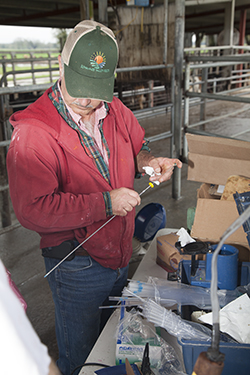 A dairy's success or failure hinges on a number of variables, one of which is a successful reproductive program. When cows fail to conceive, time, labor and capital expenses are incurred by the operation. To minimize these disruptions and irregularities, many farms will employ a timed A.I. program.
A dairy's success or failure hinges on a number of variables, one of which is a successful reproductive program. When cows fail to conceive, time, labor and capital expenses are incurred by the operation. To minimize these disruptions and irregularities, many farms will employ a timed A.I. program.It has also been documented that an episode of clinical mastitis can disrupt a cow's fertility cycle. Recent research from Cornell University estimated the effects of pathogen-specific clinical mastitis occurring at different time points before insemination on the probability of conception in Holstein cows. The study, which consisted of 90,271 A.I. events in 20,382 cows, looked at the six weeks before and after insemination and was constrained to the first four inseminations in a cow's lactation.
On the five farms studied, all participated in ovulation synchronization programs and conducted preg checks at 35 days postbreeding. Cows in the study were inseminated for the first time between 40 and 90 days in milk. Of the lactations studied (39,361), 30 percent had at least one clinical mastitis case. Streptococcus ssp., and E. coli were the most commonly isolated pathogens.
Unless it occurred in the week prior to breeding, clinical mastitis had little effect on the likelihood of conception. The largest reductions in the likelihood of conception were associated with clinical mastitis occurring in the week before A.I. or in the two weeks following breeding.
A clinical mastitis episode caused by Streptococcus ssp., reduced the probability of conception by 55 percent when it was detected in the week after breeding. Staph. aureus infections impacted conception during the same time frame.
When cases due to coagulase negative staphylococci occurred 15 to 21 days after A.I. it reduced the probability of conception by 67 percent, but when it occurred 29 to 35 days post-A.I. it elevated the chances of a cow conceiving by 55 percent.
Mastitis caused by other pathogens raised the probability of conception in the three weeks before A.I. but reduced it in the week immediately before and two weeks after breeding.
Two pathogens, E. coli and Klebsiella ssp., caused the greatest reductions in conception likelihood. Cows contracting these infections also required more services per conception than their herdmates without these types of clinical mastitis.
When clinical mastitis occurs before A.I., the reproductive system may be too impaired to initiate a pregnancy due to estrus cycle disruptions.

The author, Amanda Smith, was an associate editor and an animal science graduate of Cornell University. Smith covers feeding, milk quality and heads up the World Dairy Expo Supplement. She grew up on a Medina, N.Y., dairy, and interned at a 1,700-cow western New York dairy, a large New York calf and heifer farm, and studied in New Zealand for one semester.









